Ijraset Journal For Research in Applied Science and Engineering Technology
- Home / Ijraset
- On This Page
- Abstract
- Introduction
- Conclusion
- References
- Copyright
Intelligent Robotic Arm-Assisted Electrical Furnace for Efficient Metal Casting
Authors: Nirmal Kumar G, Janet Merlin. D, Harini. T, Naresh J, Nishanth. C. N
DOI Link: https://doi.org/10.22214/ijraset.2024.61120
Certificate: View Certificate
Abstract
This project proposes the development of an intelligent robotic arm-assisted electrical furnace system for efficient and precise metal casting. Electric furnace is used for heating purpose in various industrial production processes. Electric furnaces are used where more accurate temperature control is required. By combining the strengths of robotic automation with the clean and controllable environment of an electric furnace, the system aims to achieve Enhanced quality and reduced waste, Improved safety and reduced hazards, increased efficiency and productivity, Greater flexibility, and versatility, Reduced environmental impact. The project will explore the integration of sensors enhancing efficiency and quality control. The integration of these technologies aims to enhance productivity, precision, and safety while reducing operational costs. The robotic arm is designed to perform loading and unloading tasks, handling raw materials and moulds with exceptional accuracy and repeatability. The robotic arm can be attached to the electrical furnace. With the help of sensors, robots can manage to avoid obstacles on their paths and achieve their goals with or without prior planning, depending on the complexity of their implemented program.
Introduction
I. INTRODUCTION
A furnace is an equipment used to melt metals for casting or to heat materials to change their shape during the processing of the product or to enhance properties of the processed components. Electric furnaces are used where more accurate temperature control and relatively cleanliness is required. Melting furnaces are employed to overheat solid materials until they become liquefied.
|
MATERIAL |
MELTING POINT |
|
GOLD |
1064? |
|
SILVER |
1030? |
|
COPPER |
1084? |
|
ALUMINIUM |
600? |
A robotic arm for an electrical furnace is a specialized robotic system designed to handle tasks related to operating and maintaining electrical furnaces. They will be programmed to perform tasks such as loading and unloading materials, manipulating objects within the furnace, and monitoring temperature or other parameters. Robots can move about in the environment and take the place of humans in dangerous environments or manufacturing processes, or resemble humans in appearance, behaviour, or cognition. With the help of sensors, robots can manage to avoid obstacles on their paths and achieve their goals with or without prior planning, depending on the complexity of their implemented program.
II. LITERATURE SURVEY
- ELECTRIC MELTING FURNACE – A REVIEW (Sneha P. Gadpayle, Rashmi N. Baxi. International Journal of Emerging Science and Engineering (IJESE) ISSN: 2319–6378, Volume-2 Issue-5, March 2014)
Electric furnace is used for heating purpose in various industrial production processes. Electric furnaces are used where more accurate temperature control is required. Melting of metals, glass, and other materials has been a vital manufacturing process for several thousand years, producing molten liquids that can be poured and solidified into useful shapes.

2. DESIGN AND COMPUTATIONAL SIMULATION OF THE FURNACE (Tasnim Firdaus, Zairul Azrul Zakaria. The International Postgraduate Conference on Engineering Research (IPCER) January 2015)
The computational simulation shows that at the beginning of the heating process, the airflow inside the combustion chamber is in random movement. There is no temperature increased involved. The heat flow vector inside the combustion chamber. Meanwhile the air flow meeting the entire space in the furnace which is described as the Path line Colored by the Particles.
3. FURNACE PERFORMANCE & EVALUATION (Dipak Kumar, Abhishek Kumar, Rajesh Kr. Pandey. Journal Of Emerging Technologies and Innovative Research (JETIR) ISSN: 2349- 5162, ESTD Year: 2014)
An Electrical furnace is that generates heat by electric current. In these furnaces, gold, silver, brass, copper, and other metals are melted. In 4 comparisons to most other methods of metal melting, the electrical furnace provides a clean, energy-efficient, and well-controlled melting process. Heat-treating mild steel at temperatures ranging from 35 to 1200 for 2000 seconds was used to determine the performance of the Electric heat treatment furnace. The furnace's temperature was sustained at 1200 degrees for over 2000 seconds, showing that the furnace was meant to attain that temperature.
a. Objective
The key innovation lies in the incorporation of an intelligent robotic arm, which provides automation and process control throughout the metal melting and casting operations. The robotic arm is designed to perform loading and unloading tasks, handling raw materials and molds with exceptional accuracy and repeatability. It assists in maintaining optimal temperature conditions during the melting process, ensuring consistent quality in the final product. Additionally, the robotic arm plays a crucial role in pouring molten metal into molds, optimizing casting accuracy, and minimizing waste. Its dexterity enables precise movements, reducing the need for human intervention and thereby improving workplace safety.
B. Design in Creo Software:
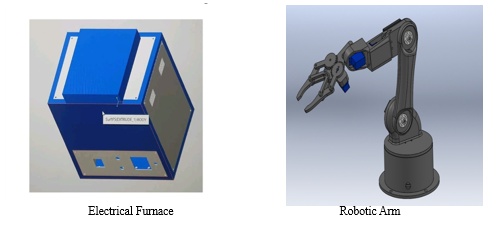
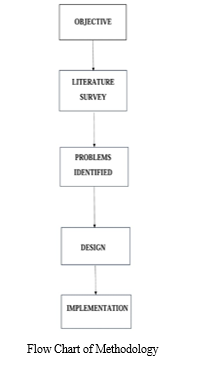
TABLE 1
CAUSES AND EFFECTS
|
PROBLEMS IDENTIFIED |
LEADS TO |
SOLUTIONS |
|
Checking the molten metal while the process by opening the door |
Small electric shocks to the handler |
Limit switches are attached so that the machine stop working while opening the door |
|
Continuous process of the machine after the power cut |
No proper shut down |
Start and stop switches are attached so that the machine stops working after the power cut |
|
Molten metal must be taken out manually using tongs |
Unsafe to handler |
Robotic arm is attached so that the molten metal can be taken out automatically |
IV. CONSTRUCTION
A. Steps to Assemble an Electrical Furnace:
- Step 1: Design an electrical furnace according to the requirement.
- Step 2: If the Coil Type Machine is made. First, fix coil inside the machine and take Glass wool and pack it on coil and keep it on MS Body Box.
- Step 3: If the Rod Type Machine is made. First, take ceramic board and pack it on the top of the MS Body Box. And by using Glass wool pack the Ceramic Board.
- Step 4: Fix Temperature Controller, and wire it. Then fix 2 – way connector and 2 – pole 40A MCB and connect it in series for all the components.
- Step 5: Fix Indicator lamp and connect it in series for power supply.
- Step 6: From Temperature Controller take a line and connect it to the Thermocouple Open Sensor.
- Step 7: If the machine is Coil Type, give input to Contactor (the input should be given from the above components and take an output from the contactor and connect it to the Coil).
- Step 8: If the machine is Rod Type, give input to Contactor
- Step 9: Connect 3 – pin top by using 3 – core wire for power supply to the
Machine and join another end of 3 – core wire in 2 – pole 4A MCB. Finally fix the door.
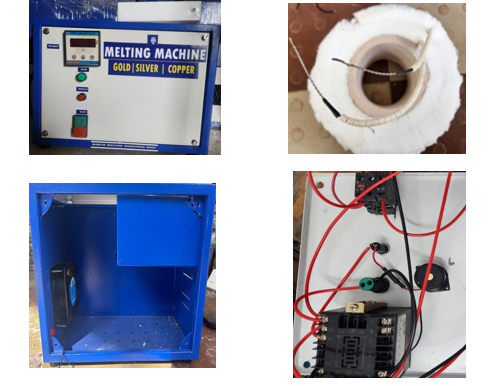
B. Steps to Assemble a Robotic Arm:
- Step 1: Gather all the components required for the robotic arm assembly, including servo motors, brackets, joints, control board, power supply, and connecting cables.
- Step 2: Start with the mechanical structure by attaching the joints and brackets. Ensure proper alignment and tight connections.
- Step2: Mount the servo motors to their designated positions on the robotic arm. Secure them tightly, and pay attention to the motor orientation specified.
- Step 3: Use connecting pieces to link the joints together. Follow the guidelines to ensure the correct order and alignment for smooth movement. Connect the servo motor wires to the control board. Pay attention to colour coding or labelling to avoid wiring errors.
- Step 4: Connect the power supply to the control board, ensuring the correct voltage and polarity. Be cautious to prevent short circuits or overloading.
- Step 5: Upload the necessary code to the control board using a computer or other programming device.
- Step 6: Conduct initial tests to check the movement and functionality of each joint. Ensure that the robotic arm operates smoothly without any unusual noises or malfunction
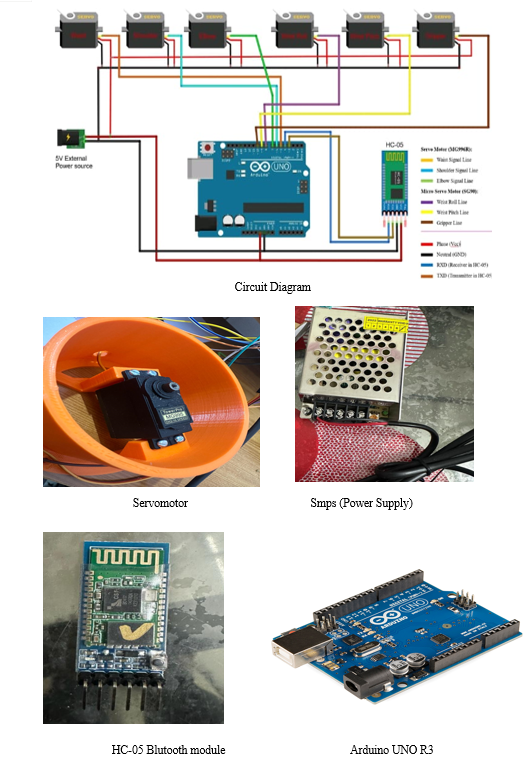
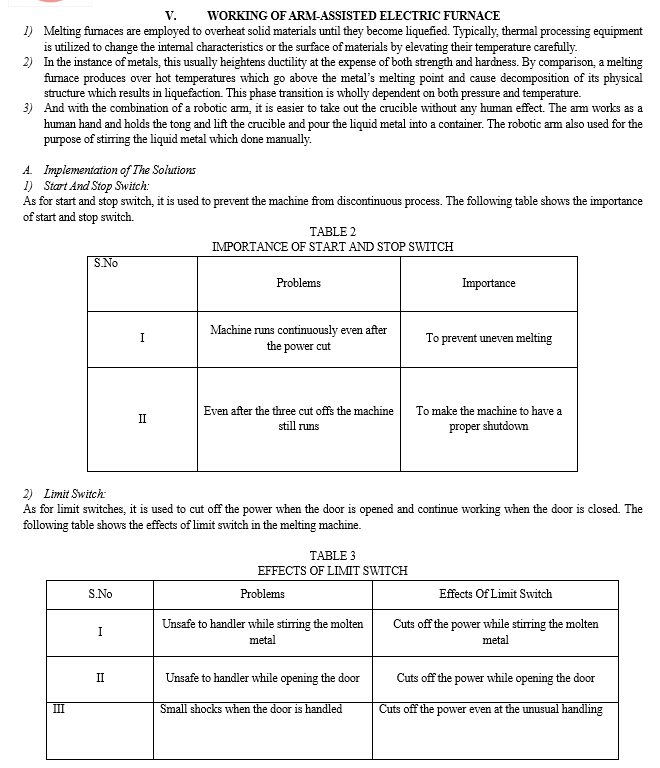

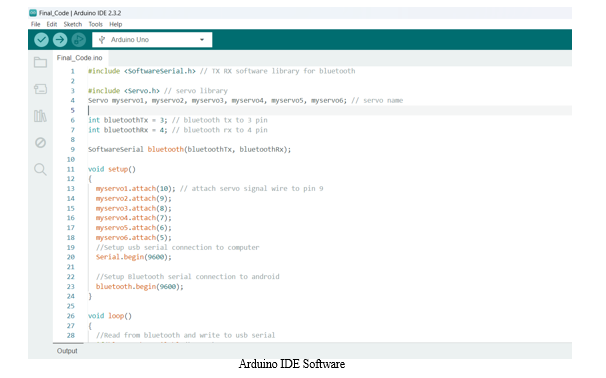
VII. MARKET POTENTIAL
Electric furnaces are used in a variety of industries, including engineering, food processing, chemical processing, and laboratories. The furnace is developed and built to the specifications of the customer. The different characteristics, such as the heating chamber's highest attainable temperature, automatic or semi-automatic temperature regulation, and so on, are determined by the customer's requirements. The expansion of industrialization affects the demand for this item. The current rate of growth in demand for this product is around 10% per year. This commodity is produced by 15 to 20 SSI units in Kerala and Tamil Nadu. Because this is industrial machinery, quality is paramount. For this experimental evaluation has reduced the human task and time and has many advantages when compared to the charcoal burner and blow pipes. And this invention has proved that the man’s intelligence is as vast as sea. And brought a new change in the practice of early days.
VIII. ADVANTAGES
- Precision: Robotic arms can perform tasks with high precision, ensuring consistent and accurate handling of materials within the furnace, leading to better quality control.
- Safety: By replacing human workers in high-temperature environments, robotic arms reduce the risk of injuries and exposure to hazardous conditions.
- Efficiency: Robotic arms can operate continuously without breaks or fatigue, leading to increased productivity and throughput in furnace operations.
- Flexibility: Robotic arms can be programmed to perform various tasks, such as loading and unloading materials, adjusting furnace settings, and conducting inspections, providing versatility in furnace operations.
- Cost-effectiveness: While the initial investment in robotic arms may be high, they can ultimately reduce labour costs and improve overall operational efficiency, resulting in long-term cost savings.
IX. TECHNOLOGY
- Sensors: Integration of sensors allows robotic arms to detect and respond to changes in temperature, pressure, and other environmental factors within the furnace, ensuring safe and efficient operation.
- Automation: Advanced programming and automation technologies enable robotic arms to perform complex tasks autonomously, such as loading and unloading materials, adjusting furnace settings based on real-time data, and optimizing energy consumption.
- Machine Learning: Utilizing machine learning algorithms enables robotic arms to learn from past experiences and optimize their movements and actions over time, leading to increased efficiency and productivity.
- Remote Monitoring and Control: Integration with remote monitoring and control systems enables operators to supervise furnace operations and adjust remotely, enhancing flexibility and convenience.
- Predictive Maintenance: By analysing data collected from sensors and monitoring systems, predictive maintenance algorithms can anticipate potential issues with the robotic arm or furnace components, enabling proactive maintenance to prevent costly downtime.
Conclusion
Integrating robotic arms with electric furnaces offers a synergistic approach that combines the precision and efficiency of automation with the reliability and versatility of electric heating technology. By harnessing advanced sensors, automation algorithms, and remote monitoring capabilities, these systems can enhance safety, productivity, and quality control in furnace operations. Furthermore, predictive maintenance techniques ensure optimal performance and minimize downtime. Overall, the combination of robotic arms and electric furnaces represents a transformative solution that optimizes processes, reduces costs, and drives continuous improvement in industrial heating applications.
References
[1] Sneha P. Gadpayle, Rashmi, N. Baxi, International Journal of Emerging Science and Engineering (IJESE) ISSN: 2319-6378, Volume-2 Issue- 5. March 2014. [2] Tasnim Firdaus, Zairul Azrul Zakaria, The International Postgraduate Conference on Engineering Research (IPCER) January 2015. [3] Website: \"Parts of Electric furnace\", [online] Available: http://www.rajasthanelectric.com [4] Dipak Kumar, Abhishek Kumar, Rajesh Kr. Pandey, Journal of Emerging Technologies, and Innovative Research (JETIR) ISSN: 2349- 5162, ESTD Year: 2014. [5] Website: “Mass finishing manufacturer”, [online] Available: http://www.shinysmooth.com [6] Mikell P Groover, Mitchel Weiss, Roger N Nagel, Nicholas G Odrey, Ashish Dutta, Industrial Robotics Technology, Programming, and Applications, Volume: 2e, pp (141) – (156). [7] P. L. Jain, 2017, “Principles of Foundry Technology”, McGraw Hill Education, Edition: 5. [8] Disha Sengupta, 2021, Robot Systems, pp (53) – (73). [9] Website: “Lighting and safety”, [online] Available: http://www.bilbtown.com
Copyright
Copyright © 2024 Nirmal Kumar G, Janet Merlin. D, Harini. T, Naresh J, Nishanth. C. N. This is an open access article distributed under the Creative Commons Attribution License, which permits unrestricted use, distribution, and reproduction in any medium, provided the original work is properly cited.

Download Paper
Paper Id : IJRASET61120
Publish Date : 2024-04-27
ISSN : 2321-9653
Publisher Name : IJRASET
DOI Link : Click Here
 Submit Paper Online
Submit Paper Online

